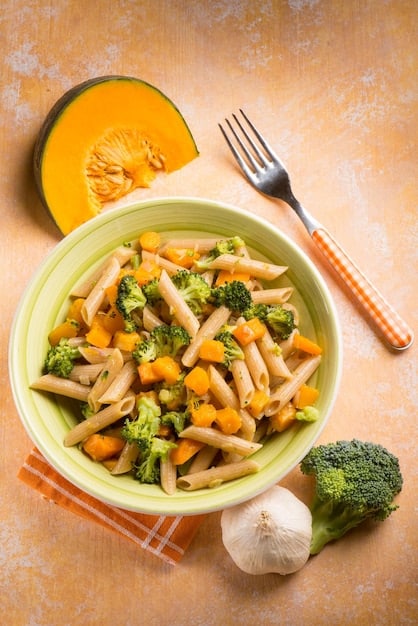Creative Ways to Sneak Vegetables into Your Child’s Meals

Discover creative and effective strategies to incorporate vegetables into your child’s favorite dishes without them even noticing, ensuring they get the nutrients they need.
Getting your child to eat their vegetables can feel like a daily battle. But what if you could boost their nutrition without the fuss? Here are some creative ways to sneak vegetables into your child’s favorite meals, making healthy eating fun and easy.
Understanding the Picky Eater
Picky eating is a common phase in childhood. Understanding why kids resist vegetables can help you find effective solutions to sneak those nutrients in without causing mealtime stress.
It’s crucial to recognize that a child’s reluctance to eat vegetables isn’t about defiance; it’s often related to taste preferences, textures, and even visual appeal. So, how can we navigate these challenges?
Why Kids Reject Vegetables
Children’s taste buds are different from adults. They tend to prefer sweeter and milder flavors, making some vegetables, with their often bitter or strong tastes, less appealing.
- Taste Sensitivity: Kids have more taste buds than adults, making them more sensitive to bitter tastes often found in vegetables like broccoli and Brussels sprouts.
- Texture Aversion: Some children dislike the texture of certain vegetables, such as the slimy texture of cooked spinach or the grainy texture of overcooked peas.
- Neophobia: This is the fear of new foods, and it’s common in young children. Introducing new vegetables gradually and regularly can help overcome this.

Recognizing these factors allows parents to approach meal times with more empathy and creativity. The goal isn’t to force-feed, but rather to find sneaky ways to include vegetables in a way that kids enjoy, or at least don’t notice!
Puree Power: The Art of Blending
Pureeing vegetables is a fantastic way to incorporate them into sauces, soups, and baked goods. This method allows you to add nutrients without drastically changing the flavor or texture of the meal.
The key to successful pureeing is to choose vegetables that complement the dish’s existing flavors. Here’s how to master the art of blending.
Vegetables That Blend Well
Certain vegetables are naturally sweeter or have a milder flavor, making them ideal for pureeing into various dishes. Consider these options:
- Carrots: Carrots add sweetness and a vibrant color to sauces, soups, and even smoothies.
- Spinach: Spinach blends seamlessly into pasta sauces, smoothies, and baked goods, adding a boost of iron and vitamins.
- Zucchini: Zucchini has a mild flavor and blends well into muffins, bread, and sauces without being detected.
Experimenting with different vegetables helps you discover new ways to enhance your child’s favorite meals. Remember, the goal is to add nutrients, not to completely alter the taste.
Sauce and Smoothie Secrets
Sauces and smoothies are excellent vehicles for sneaking in vegetables. By adding pureed vegetables or finely chopped greens, you can boost the nutritional value of these family favorites.
These methods are simple, effective, and can be easily adapted to suit your child’s preferences.
Transforming Tomato Sauce
Tomato sauce is a staple in many households and a perfect candidate for vegetable additions. Try these tips:
- Add Pureed Vegetables: Blend carrots, zucchini, bell peppers, or spinach into your tomato sauce. These vegetables will add nutrients and depth of flavor.
- Finely Grated Veggies: Grate zucchini or carrots directly into the sauce while it simmers. They will cook down and become virtually undetectable.
- Roast Vegetables First: Roasting vegetables like tomatoes, bell peppers, and onions before blending them into the sauce can enhance their natural sweetness and flavor.
With a little creativity, you can transform ordinary tomato sauce into a nutritional powerhouse, making it a healthy and delicious addition to any meal.
Baking with Benefits
Baking is another great way to sneak vegetables into your child’s diet. From muffins and bread to cookies and cakes, there are countless opportunities to add hidden nutrients.
The key is to choose recipes that can easily incorporate pureed or grated vegetables without compromising the taste or texture.
Hidden Veggie Muffins
Muffins are a versatile treat that can be packed with hidden vegetables. Here are a few ideas:
- Zucchini Muffins: Add grated zucchini to your favorite muffin recipe. The zucchini adds moisture and nutrients without altering the flavor.
- Carrot Muffins: Pureed carrots or finely grated carrots can be added to muffin batter for a sweet and nutritious treat.
- Spinach Muffins: Blend spinach into a small amount of milk or yogurt, then add it to your muffin batter for a boost of vitamins and minerals.

By experimenting with different recipes and vegetables, you can create delicious and healthy baked goods that your child will love. Plus, you’ll feel good knowing they’re getting a serving of vegetables without even realizing it!
Presentation is Key: Making it Appealing
How food is presented can significantly impact whether a child is willing to try it. Making meals visually appealing can encourage picky eaters to give new foods a chance.
Consider these creative presentation techniques to make vegetables more enticing.
Fun Shapes and Colors
Children are naturally drawn to bright colors and interesting shapes. Try these ideas:
- Cut Vegetables into Fun Shapes: Use cookie cutters to create fun shapes out of vegetables like cucumbers, carrots, and bell peppers.
- Arrange Vegetables in a Rainbow: Create a colorful vegetable platter with a variety of veggies arranged in a rainbow pattern.
- Use Colorful Plates and Utensils: Brightly colored plates and utensils can make meal times more fun and engaging.
Transforming ordinary meals into visually appealing creations can make a big difference in your child’s willingness to try new vegetables. Make meal times fun and exciting, and watch your child’s attitude towards vegetables change.
Get Kids Involved: Cooking Together
Involving children in the cooking process is a fantastic way to get them excited about trying new foods. When kids help prepare a meal, they’re more likely to taste it.
There are many age-appropriate tasks that children can participate in, from washing vegetables to stirring ingredients.
Age-Appropriate Cooking Tasks
Here are some tasks that children of different ages can help with:
- Toddlers: Washing vegetables, tearing lettuce, and stirring ingredients under supervision.
- Preschoolers: Measuring ingredients, pouring liquids, and arranging vegetables on a plate.
- School-Age Children: Chopping vegetables (with supervision), reading recipes, and setting the table.
By involving your child in the cooking process, you’re not only teaching them valuable skills but also helping them develop a positive relationship with food. Plus, it’s a great way to spend quality time together in the kitchen!
| Key Point | Brief Description |
|---|---|
| 🥕 Puree Power | Blend veggies into sauces and soups for hidden nutrients. |
| 🥦 Baking Benefits | Incorporate veggies into muffins and bread for a healthy twist. |
| 🎨 Presentation | Make veggies appealing with fun shapes and colors. |
| 🧑🍳 Get Involved | Cook together to encourage trying new foods. |
FAQ
▼
Carrots, spinach, and zucchini are excellent for pureeing due to their mild flavor and ability to blend smoothly into sauces and baked goods.
▼
Add pureed carrots, zucchini, or bell peppers to your tomato sauce to boost its nutritional value. Roasting the vegetables first enhances their flavor.
▼
Use cookie cutters to create fun shapes, arrange vegetables in a rainbow pattern, or use colorful plates and utensils to make meal times more engaging.
▼
Let toddlers wash vegetables, preschoolers measure ingredients, and school-age children chop vegetables (with supervision). Involving them makes them more likely to try new foods.
▼
Muffins, pasta sauces, and smoothies are great for hiding vegetables. These can easily incorporate pureed or grated vegetables without altering the taste too much.
Conclusion
Sneaking vegetables into your child’s favorite meals doesn’t have to be a chore. With creativity and a little planning, you can boost their nutrition while minimizing mealtime battles. Experiment with purees, sauces, and baking, and don’t forget to involve your child in the cooking process. Happy cooking!





